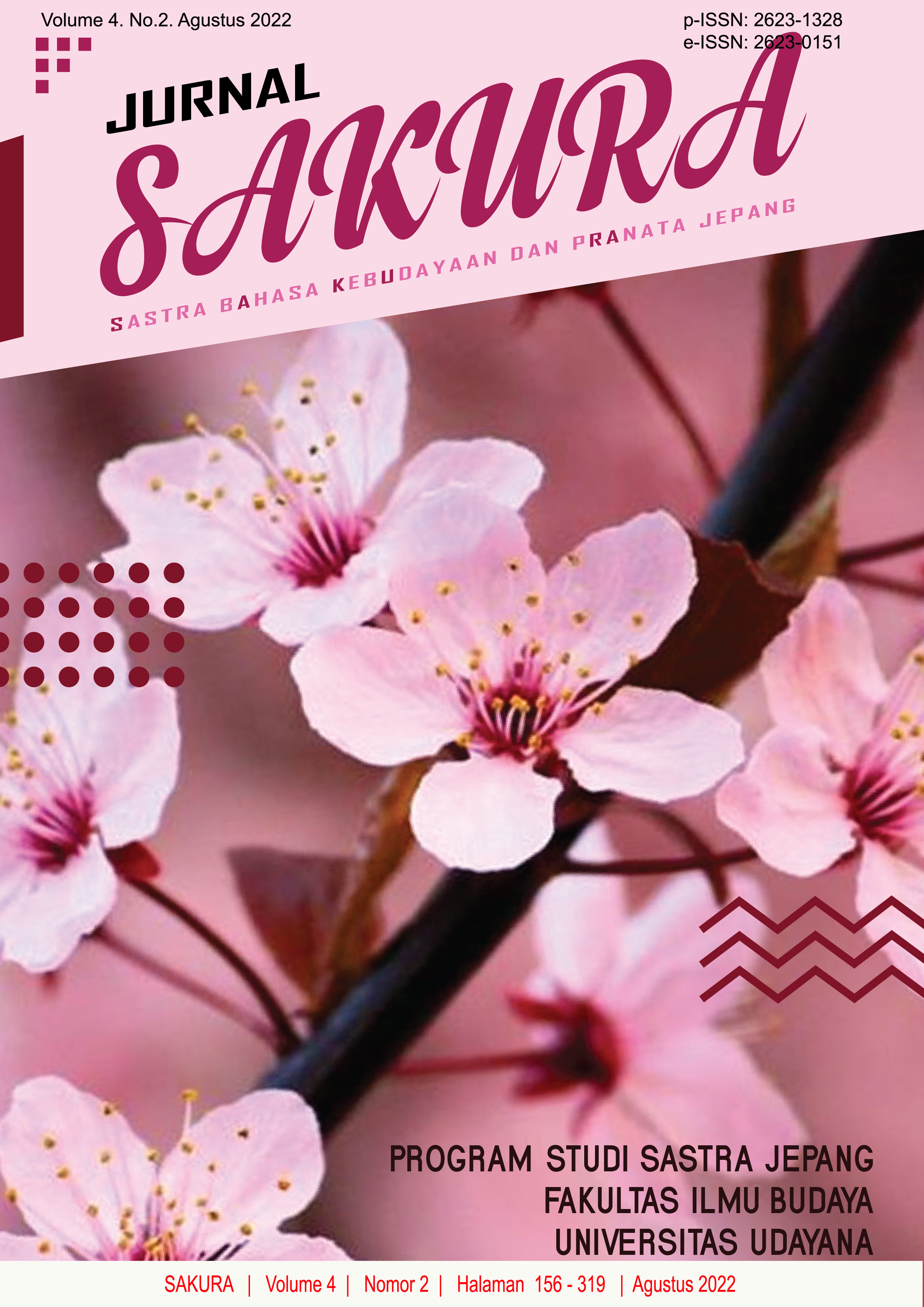Analisis Simbolisme Jepang dalam Seragam Sekolah Menengah Pertama
Abstract
The symbols on junior high school uniforms in Japan have different meanings. The purpose of this study is to describe the meaning of semiotics (denotative, connotative, and myth) in junior high school uniforms in Japan using Roland Barthes' semiotic theory. This research is a qualitative descriptive study research with literature study data collection techniques. The results of the analysis show six symbols whose meanings can be known, namely the school uniform was not only clothes worn by certain groups, but there are several semiotic meanings contained in parts of the school uniform. In addition, school coats are required to be in a dark color, which is a tradition in Japan where students are prohibited from wearing brightly colored coats. They wear a suit collar with a standard collar shape which is the best collar to use in any occasion, the symbol in the middle of the coat buttons means an identifier of the origin of the uniform, the coat pocket is decorative and is used to place an item. Then the purpose of using ties is for the student to be more confident and learn to dress neatly, white school shirts like school shirts in general symbolize cleanliness and innocence which makes students look formal when attending school, and school skirts that cover part or all of their legs part to show the feminist side of female students.
Downloads
References
Davies, Roger. 2002. The Japanese Mind: Understanding Contemporay Culture. Singapore: Tuttle Publishing.
Satori, Djam’an. 2009. Metodelogi Penelitian Kualitatif. Bandung: Alfabeta.
Afifuddin. 2009. Metodelogi Penelitian Kualitatif. Bandung: Pustaka Setia.
Hamada. 2010. The Traditional Color of Japan. Japan: PIE International.
Meyrasyawati, Dewi. 2013. Fesyen dan Identitas: Simbolisasi Budaya dan Agama dalam Busana Pengantin Jawa Muslim di Surabaya. Surabaya: Universitas Airlangga
Sugiyono. 2016. Metode Penelitian Kualiatif, Kuantitatif dan R&D. Bandung: PT Alfabet.
Barthes, Roland. 2017. Elemen-Elemen Semiologi. Yogyakarta: BASABASI.
Suwendra, I Wayan. 2018. Metodologi Penelitian Kualitatif Dalam Ilmu Sosial, Kebudayaan, dan Keagamaan. Bandung: Nilacakra.
Firdaus, Nadia. 2018. Wacana Feminisme pada Rubrik Fashion & Style dalam Situs Online Perempuan Fimela. Surabaya: Universitas Airlangga.
Nababan, Erson. 2018. Fungsi Sosial Seragam Sekolah Dasar di Jepang. Medan: Univesitas Sumatera Utara.
Hudzaifah dkk. 2011. Analisis Pemakaian Seragam Sekolah Siswa SMK Dalam Tinjauan Pendidikan Kritis Surakarta: Universitas Sebelas Maret.
Tia dkk. 2019. Analisis Pengaruh Budaya Kawaii dalam Dunia Fashion di Jepang. Jakarta: Universitas Darma Persada.
Ayu, Anisa. 2020. Analisis Semiotika Pada Pakaian Tradisional Jepang Kimono Kurotomesode. Purwokerto: Universitas Jenderal Soedirman
Rakhma. 2021.Unik! Tradisi “Kancing Kedua” Saat Hari Kelulusan Sekolah di Jepang.
https://japanesestation.com/culture/tradition/unik-tradisi-kancing-kedua-saat-hari-kelulusan-sekolah-di-jepang [diakses pada 27 Desember 2021]
Hendara, Adrian. 2016. Inilah sebab siswi di jepang mengenakan rok pendek.
https://japanesestation.com/lifestyle/life-relationship/inilah-sebab-siswi-di-jepang-mengenakan-rok-pendek/ [diakses pada 27 Desember 2021]
Desti. 2020. Mengapa siswi jepang suka pakai rok pendek.
https://inibaru.id/hits/mengapa-siswi-jepang-suka-pakai-rok-pendek
[diakses pada 7 Januari 2022]
The NCD Risk Factor Collaboration (NCD-RisC). 2020. Height: Evolution of Height Overtime
https://ncdrisc.org/height-mean-map.html [diakses pada 13 Januari 2022]













